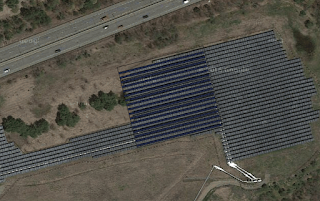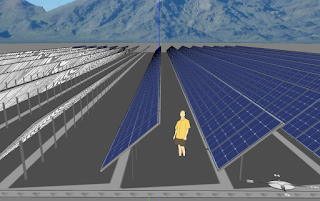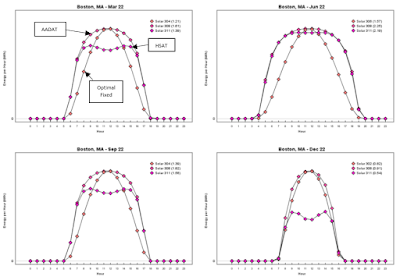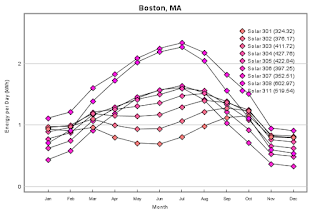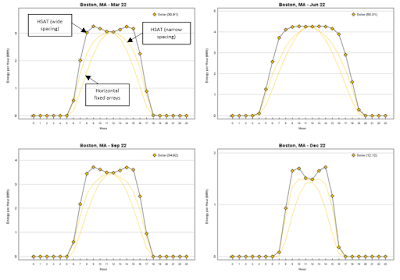 |
| Fig. 1: Visualizing shadowing loss |
As a one-stop-shop for solar solutions,
Energy3D supports the design of
concentrated solar power (CSP) stations. Although the main competitor of the CSP technology, the photovoltaic (PV) power stations, have become dominant in recent years due to the plummet of PV panel price, CSP has its own
advantages and potential, especially in energy storage. According to the US Department of Energy,
the levelized cost of electricity (LCOE) for CSP has dropped to 13 cents per kWh in the US in 2015, comparable to the LCOE for PV (12 cents per kWh). In general, it is always better to have options than having none. A combination of PV and CSP stations may be what is good for the world: CSP can complement PV to generate stable outputs and provide electricity at night. As a developer of solar design and simulation software, we are committed to supporting the research, development, and education of all forms of solar technologies.
Numerical simulation plays an important role on designing optimal CSP stations. Concentrated solar power towers are the first type of CSP stations covered by the modeling engine of Energy3D. This blog post shows some progress towards the goal of eventually building a reliable simulation and visualization kernel for CSP tower technology in Energy3D. The progress is related to the study of
heliostat layouts (the heat transfer part is yet to be built).
Numerous studies of heliostat layouts have been reported in literature in the past three decades, resulting in a variety of proposals for minimizing the land use and/or maximizing the energy output (see a recent review:
Li, Coventry, Bader, Pye, & Lipiński, Optics Express, Vol. 24, No. 14, pp. A985-A1007, 2016). The latest is an interesting biomimetic pattern suggested by Noone, Torrilhon, and Mitsos (
Solar Energy, Vol. 862, pp. 792–803, 2012), which resembles the spiral patterns of a sunflower head (each floret is oriented towards the next by the golden angle of 137.5°, forming a
Fermat spiral that is probably Mother Nature's trick to ensure that each seed has enough room to grow and fair access to sunlight).
 |
| Fig. 2: Visualizing blocking loss |
If you haven't worked in the field of solar engineering, you may be wondering why there has been such a quest for optimal layouts of heliostats. At first glance, the problem seems trivial -- well, a tower-based CSP station is just a gigantic solar cooker, isn't it? But things are not always what they seem.
The design of the heliostat layout is in fact a very complicated mathematical problem. We have some acres of land somewhere to begin with. The sun moves in the sky and its trajectory varies from day to day. But that is OK. The heliostats can be programmed to reflect sunlight to the receiver automatically. These all sound good until we realize that the heliostats' large reflectors can cast shadow to one another if they are too close or the sun is low in the sky (Figure 1). Like the case of PV arrays,
shadowing causes productivity loss (but luckily, reflectors -- unlike solar panels based on strings of connected solar cells -- do not completely lose power if only a part of it is in the shadow).
 |
| Fig. 3: Annual outputs of the heliostats in Fig. 2 |
Unlike the case of PV arrays, heliostats have an extra problem --
blocking. A heliostat must reflect the light to the receiver at the top of the tower and that path of light can be blocked by its neighbors. Of course, we rarely see the case of complete blocking. But if a portion of the reflector area is denied optical access to the receiver, the heliostat will lose some productivity. Energy3D can visualize this loss on each heliostat reflector. The upper image of Figure 2 shows the insolation to the reflectors whereas the lower one shows the portion of the insolation that actually reaches the receiver (you can see that the reflectors closer to the tower get more insolation). Figure 3 shows a comparison of the outputs of the heliostats over the course of a year. As you can see, the blue parts of the reflectors can never bounce light to the receiver because the heliostats in front of them block the reflection path for the lower parts of those heliostats. The way to mitigate this issue is to gradually increase the spacing between the heliostats when they are farther away from the tower.
 |
| Fig. 4: Visualizing cosine efficiency |
Another problem with CSP tower technology is the so-called
cosine efficiency. As we know, the insolation onto a surface is maximal when the surface directly faces the sun (this is known as
the projection effect). In the northern hemisphere, however, the heliostats to the south of the tower (the south field) cannot face the sun directly as they must be positioned at an angle so that the incident sunlight can be reflected to a northern position (where the receiver is located). Figure 4 shows a visualization of the cosine effect and Figure 5 shows the comparison of the annual outputs of the heliostats. Clearly, the cosine efficiency is the lowest in the winter and the highest in the summer.
 |
| Fig. 5: Cosine efficiency is lower in the winter |
Does the cosine efficiency mean that we should only deploy heliostats in the north field as is shown in Figure 6? This depends on a number of factors. Yes, the cosine efficiency does reduce the output of a heliostat in the south field in the winter (maybe early spring and late fall, too), but a heliostat far away from the tower in the north field also produces less energy. For a utility-scale CSP station that must use thousands of heliostats, the part of the south field close to the tower may not be such a bad place to put heliostats, compared with the part of the north field far away from the tower. This is more so when the site is closer to the equator. If the site is at a higher latitude to the point that it makes more sense to deploy all heliostats in the north field, dividing the site into multiple areas and constructing a tower for each area may be a desirable solution. The downside is that additional towers will increase the constructional cost.
 |
| Fig. 6: Semicircular layout in the north field |
We now multiply these three problems (shadowing, blocking, and cosine effect) with thousands of heliostats, confine them within an area of a given shape, and want to spend as less money as possible while producing as much electricity as possible. That is the essence of the mathematical challenge that we are facing in CSP field design. With even more functionalities to be added in the future, Energy3D could become a powerful design tool that anyone can use to search for their own solutions.

















